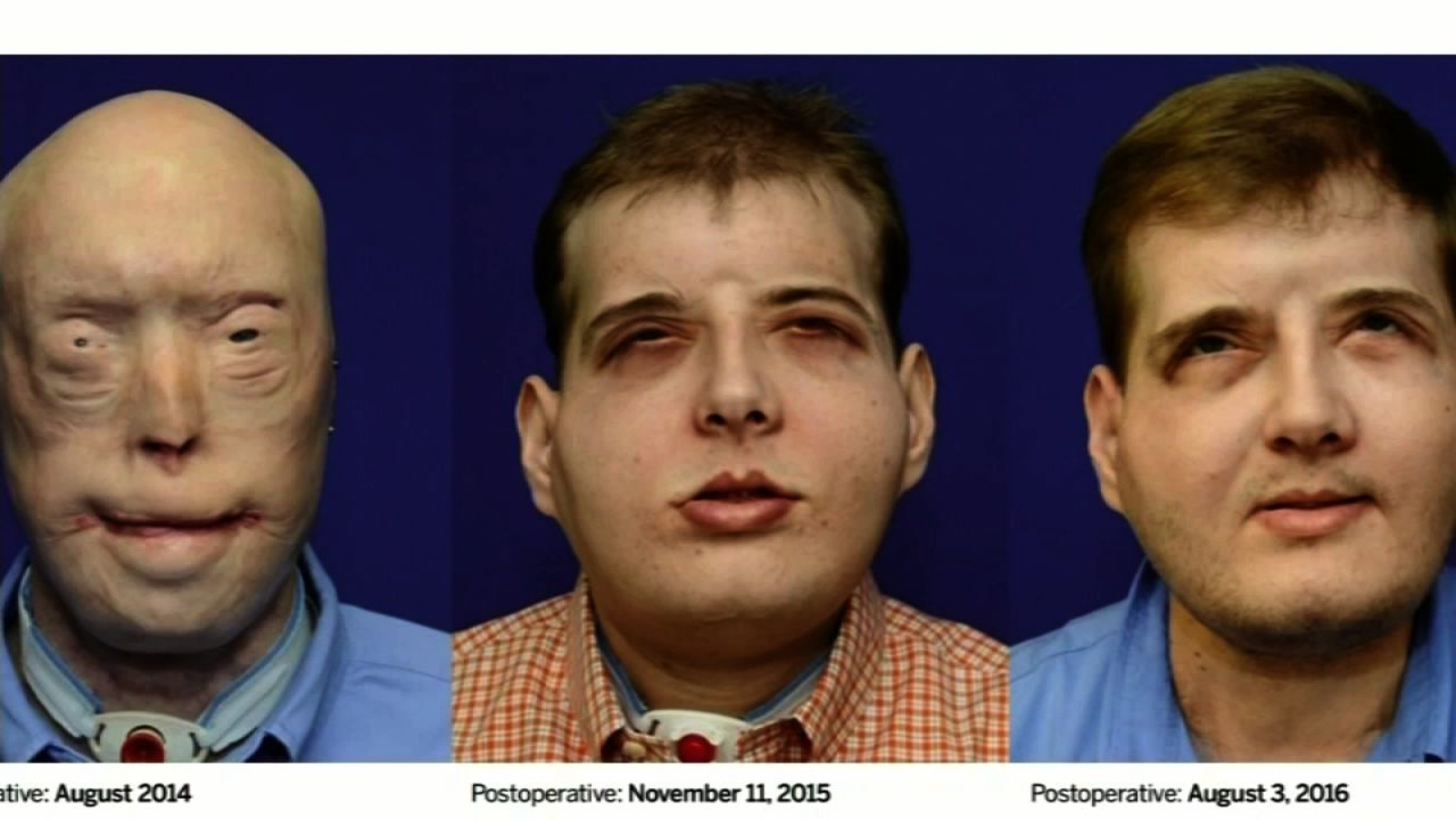Firefighter Who Injured His Face Completely In Fire Undergoes Historic Face Transplant
Firefighter who injured his face completely in fire undergoes historic face transplant. In September 2001, Patrick Hardison, a firefighter from Mississippi, sustained severe burns to his face while responding to a house fire.
Author:Black Crystal Reviewer:Maxwell CanvasMar 23, 2023154 Shares2K Views

Firefighter who injured his face completely in fire undergoes historic face transplant. In September 2001, Patrick Hardison, a firefighter from Mississippi, sustained severe burns to his face while responding to a house fire.
The incident left him disfigured and in constant pain. For over a decade, Hardison struggled to lead a normal life and underwent multiple reconstructive surgeries. However, none of the procedures were able to restore his face to its pre-accident appearance or alleviate his suffering.
Firefighter who injured his face completely in fire undergoes historic face transplant. In 2015, Hardison made history by undergoing the most extensive face transplant surgery ever performed. The procedure, which involved transplanting the face of a donor onto Hardison's own, was a remarkable success.
Today, Hardison is able to breathe, speak, and eat normally, and has regained much of his facial function. His story has inspired many and shed light on the groundbreaking advances in medical technology.
Patrick Hardison's face transplant surgery in 2015 was a groundbreaking achievement in the field of reconstructive surgery. Hardison had been living with severe facial disfigurement for over a decade after being severely burned in a fire while responding to an emergency call as a firefighter.
He underwent multiple reconstructive surgeries, but none of them were able to restore his face to its pre-accident appearance.
After years of living with physical pain, social isolation, and depression, Hardison was presented with an opportunity for a face transplant, which offered him a chance at a new life.
The procedure, which took place at NYU Langone Medical Center in New York City, was a complex operation that involved transplanting the face, eyelids, ears, scalp, and other structures from a donor onto Hardison's face. The surgery lasted 26 hours and involved a team of more than 100 medical professionals.
Hardison's new face was customized to match his own facial features, and the surgical team took great care to ensure that the blood vessels, nerves, and muscles were properly connected. After the surgery, Hardison was kept in a medically induced coma for several days to allow his body to heal.
The recovery process was a long and challenging journey for Hardison, but he was determined to regain his health and return to a normal life.
He underwent months of physical therapy, speech therapy, and counseling to help him adjust to his new appearance and learn to use his facial muscles. Today, he is able to breathe, eat, and speak normally and has regained much of his facial function.
Hardison's story has inspired many and shed light on the advances in medical technology that make face transplants possible. The procedure offers a new hope for patients who have suffered severe facial trauma and are unable to lead a normal life.
However, it is important to note that face transplantation is a complex and risky surgery that requires extensive preparation, a highly skilled surgical team, and a rigorous post-operative care plan.
Furthermore, the emotional and psychological impacts of facial disfigurement cannot be overlooked. Patients who have suffered severe facial trauma may experience anxiety, depression, and social isolation. It is essential to provide patients with adequate support and care throughout the recovery process and address their emotional and mental health needs.
Face transplantation is a relatively new medical procedure that involves transplanting the face of a deceased donor onto a patient who has suffered extensive facial injuries.
The procedure requires a team of specialized surgeons, as well as extensive preparation and post-operative care. However, for patients like Patrick Hardison, face transplants offer a chance at a new life.

Burned Firefighter Receives Face Transplant
The science of face transplants is constantly evolving, and researchers are working to improve the procedure and reduce the risks associated with it. As of 2021, over 40 face transplants have been performed worldwide, with varying degrees of success.
While the procedure is still rare, it holds promise for patients who have suffered severe facial trauma and are unable to lead a normal life.
Facial disfigurement can have a profound impact on a person's mental health and well-being. Patients who have suffered severe facial injuries may experience depression, anxiety, and social isolation.
They may also struggle with self-esteem and body image issues, which can affect their ability to form relationships or pursue career opportunities.
Can Face Transplants Be Performed On Anyone With Facial Disfigurement?
Face transplant surgery is a groundbreaking medical procedure that involves transplanting all or part of a donor's face onto a recipient who has suffered severe facial disfigurement.
This procedure has the potential to restore a person's appearance, improve their ability to eat and breathe and enhance their quality of life.
However, not everyone who has facial disfigurement is a candidate for face transplant surgery. The procedure is reserved for patients with severe disfigurement due to trauma, burns, or congenital defects.
The screening process for potential face transplant recipients is rigorous and involves a team of medical professionals, including transplant surgeons, plastic surgeons, psychiatrists, and social workers.
During the evaluation process, medical professionals assess the patient's physical health, psychological readiness for the procedure, and willingness to commit to lifelong immunosuppressive therapy.
Immunosuppressive therapy is necessary to prevent the rejection of the transplanted tissue, as the recipient's immune system may recognize the new tissue as foreign and attack it.
In addition to meeting medical criteria, potential face transplant recipients must also undergo extensive counseling to ensure that they fully understand the risks and benefits of the procedure, as well as the lifelong commitment involved.
The face transplant procedure itself is complex and can take anywhere from 12 to 36 hours to complete. During the surgery, the recipient's damaged or missing facial tissue is removed, and the donor's face is transplanted onto the recipient.
The blood vessels, nerves, and muscles of the transplanted tissue are then connected to the recipient's own blood vessels, nerves, and muscles, in a process known as vascular anastomosis.
Following the surgery, the recipient is closely monitored for signs of rejection, infection, or other complications. Recovery can be a long and challenging process, and may involve physical therapy, occupational therapy, and counseling.
Despite the risks and challenges involved, face transplant surgery has the potential to change the lives of people with severe facial disfigurement. It is a testament to the remarkable advances in medical technology and our ability to improve the quality of life for those who have suffered traumatic injuries or congenital defects.
People Also Ask
What Is A Face Transplant, And How Does It Work?
A face transplant is a complex surgical procedure that involves removing the face, eyelids, ears, scalp, and other structures from a donor and transplanting them onto a recipient who has suffered severe facial trauma. The procedure is performed by a team of medical professionals who carefully connect the blood vessels, nerves, and muscles to ensure proper function and appearance.
What Led To Patrick Hardison's Need For A Face Transplant?
Patrick Hardison was a firefighter who suffered severe facial burns while responding to an emergency call in 2001. Despite multiple surgeries over the years, he was left with significant facial disfigurement that caused him physical pain, social isolation, and depression.
How Successful Was Patrick Hardison's Face Transplant Surgery?
Patrick Hardison's face transplant surgery was considered a success, as he was able to regain much of his facial function and lead a more normal life. He underwent months of physical and speech therapy to help him adjust to his new appearance and learn to use his facial muscles.
What Are Some Of The Risks And Challenges Associated With Face Transplant Surgery?
Risks include rejection of the transplanted tissue, infections, and complications related to the use of immunosuppressant drugs. Patients also need to undergo extensive physical and psychological therapy to adjust to their new appearance and cope with the emotional impact of the surgery.
Conclusion
Firefighter who injured his face completely in fire undergoes historic face transplant. For patients like Patrick Hardison, face transplantation can be life-changing not only for the physical transformation but also for the psychological impact. The procedure can help patients regain their sense of self and allow them to lead a more fulfilling life.
However, it is important to address the emotional and mental health needs of patients who have suffered facial trauma and ensure they receive adequate support and care throughout the recovery process.

Black Crystal
Author
Black Crystal is a captivating writer who finds inspiration in the quiet corners of the street and the mysterious depths beneath bridges. With a penchant for the night, she crafts enchanting tales that explore the uncharted realms of the human experience. Embracing the darkness as her muse, Black Crystal's evocative prose and haunting imagery transport readers into a world where secrets whisper and dreams take shape.
Her writing defies categorization, inviting readers to uncover the magic hidden within the shadows and embrace the enigmatic beauty of her nocturnal narratives. Step into her realm, where the written word dances with ethereal grace, and immerse yourself in the captivating stories she weaves.

Maxwell Canvas
Reviewer
Maxwell Canvas, a charismatic and fearless crypto evangelist, defies conventions and blazes a trail in the realm of digital currencies. With his unique physique serving as a symbol of resilience, he challenges societal norms and proves that true expertise transcends appearances. Against a backdrop of a blurred and ever-shifting market, Maxwell's work becomes a masterpiece, painting a vivid picture of knowledge and inspiration.
With unwavering passion, Maxwell empowers others to embrace the transformative potential of blockchain technology. His captivating presence and unyielding dedication captivate audiences, turning skepticism into curiosity and igniting a spark of interest in the world of cryptocurrencies. Maxwell Canvas stands as a visionary force, leaving an indelible mark on the crypto landscape, inspiring others to explore decentralized possibilities and embrace a future of innovation and financial empowerment.
Latest Articles
Popular Articles